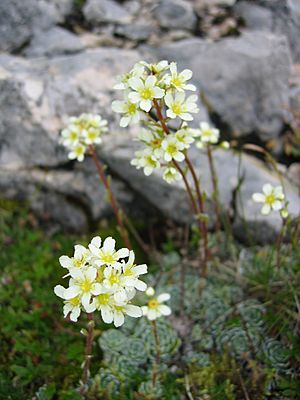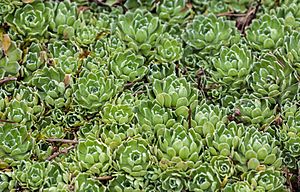Alpine saxifrage facts for kids
Quick facts for kids Alpine saxifrage |
|
|---|---|
 |
|
| Scientific classification | |
| Genus: |
Saxifraga
|
| Species: |
paniculata
|
| Synonyms | |
|
Synonyms
Chondrosea aizoon (Jacq.) Haw.
Chondrosea aizoopsis Jord. & Fourr. Chondrosea alpicola Jord. & Fourr. Chondrosea beugesiaca Jord. & Fourr. Chondrosea brevicaulis Jord. & Fourr. Chondrosea calcarea Jord. & Fourr. Chondrosea carthusiana Jord. & Fourr. Chondrosea cartilaginea (Willd.) Haw. Chondrosea flexipes Jord. & Fourr. Chondrosea glabrata Jord. & Fourr. Chondrosea glareosa Jord. & Fourr. Chondrosea gracilescens Jord. & Fourr. Chondrosea laevigata Jord. & Fourr. Chondrosea leptopetala Jord. & Fourr. Chondrosea orophila Jord. & Fourr. Chondrosea paniculata (Mill.) Á.Löve Chondrosea patulipes Jord. & Fourr. Chondrosea petrophila Jord. & Fourr. Chondrosea punctillata Jord. & Fourr. Chondrosea pusilla Jord. & Fourr. Chondrosea refracta Jord. & Fourr. Chondrosea rosella Jord. & Fourr. Chondrosea rosularis Haw. Chondrosea valida Jord. & Fourr. Chondrosea virgata Jord. & Fourr. Chondrosea viridula Jord. & Fourr. Saxifraga aizoon Jacq. Saxifraga carinthiaca Schott Saxifraga cartilaginea Willd. Saxifraga chlorantha Dulac nom. illeg. Saxifraga compacta Hegetschw. nom. illeg. Saxifraga cordi Bubani Saxifraga cultrata Schott Saxifraga dilatata Schott Saxifraga elatior Wimm. nom. illeg. Saxifraga intacta Willd. Saxifraga kolenatiana Regel Saxifraga laeta Schott Saxifraga maculata Schrank Saxifraga malyi Schott Saxifraga neglecta Ten. Saxifraga notata Schott Saxifraga recta Lapeyr. Saxifraga robusta Schott Saxifraga rosularis Haw. Saxifraga stabiana Ten. Saxifraga stenoglossa Tausch ex Schott Saxifraga sturmiana Schott Saxifraga zeleborii Schott |
|
Saxifraga paniculata is a type of flowering plant that grows in mountain areas. It belongs to the saxifrage family. You can find it in cooler parts of the northern half of the world.
Some common names for this plant are alpine saxifrage, encrusted saxifrage, lifelong saxifrage, lime-encrusted saxifrage, livelong saxifrage, white mountain saxifrage, and silver saxifrage.
Contents
What's in a Name?
The plant Saxifraga paniculata was first officially described in 1768 by a Scottish botanist named Philip Miller. It's part of the Saxifraga group of plants, which are all in the Saxifragaceae family.
The name Saxifraga comes from two Latin words: saxum, meaning "rock" or "stone," and frangere, meaning "to break." So, Saxifraga literally means "stone-breaker." People used to think this plant could help treat kidney stones, which are like small stones that can form inside your body.
What Does It Look Like?
Saxifraga paniculata is a perennial plant, meaning it lives for more than two years. It's also a herbaceous plant, which means it has soft stems instead of woody ones. Its flowering stems can grow to be about 10–30 cm (4–12 inches) tall.
The easiest way to spot this plant is by its thick cluster of leaves at the bottom, called a basal rosette. These leaves are tough, flat, and stiff. They are usually 1–3 cm long and have small teeth along their edges. Each leaf has a tiny white pore at its base that looks like it's covered in lime. The rosettes can also grow new plants at the end of runners, which are like horizontal stems.
The flowering stems have fewer, scattered leaves. At the top, they have a cluster of white flowers. Each flower is about 1 cm (0.4 inches) wide and has purplish or red dots. The plant flowers from mid-June to early August. Its flowers have five petals, and they produce both pollen and seeds. After flowering, it forms a two-beaked seed capsule.
Sometimes, Saxifraga paniculata can be confused with another plant in the same group, Saxifraga tricuspidata. However, S. tricuspidata doesn't have the lime-encrusted pores and its leaves are narrower with three spine-tipped teeth.
Where Does It Grow?
Saxifraga paniculata grows in many cold regions around the world. You can find it in Central Europe, Greenland, Iceland, and Scandinavia. It also grows in the Caucasus mountains and in North America. In North America, it's found in the northern Great Lakes area, New England, and New York State. It's quite rare in places like Vermont and Minnesota.
This plant loves calcium-rich places. This means it often grows in cracks in rocks that contain a lot of calcium, like basalt or other volcanic rocks. It prefers shady spots on these rock ledges or crevices.
How It Survives
Saxifraga paniculata is very tough! It can close its leaf rosettes when it's too hot or dry. This helps it survive extreme conditions like intense heat and droughts. It's also very good at handling cold weather. Scientists found that it's more resistant to cold damage in winter than many other evergreen plants that grow in high mountain areas.
Because the growing season in its habitat is short and there might not be many pollinators around, Saxifraga paniculata can self-pollinate. This means it can make seeds using its own pollen. While this doesn't create new genetic variation, it ensures that the plant can still produce seeds and continue its species even when conditions are difficult.
In the wild, Saxifraga paniculata often grows near other plants. Some of these include Trisetum spicatum, Polygonum viviparum, Polypodium virginianum, Campanula rotundifolia, and various types of lichen.
Growing It in Your Garden
People sometimes grow Saxifraga paniculata as an ornamental plant in gardens. It's a hardy plant, meaning it can withstand tough weather. However, it doesn't like too much wetness in winter. It needs soil that drains water very well and is either alkaline (basic) or neutral.
Because of these needs, it's often grown in a rock garden or a special alpine house. This plant has also been used to create many new cultivars (plant varieties developed by people). Some of these have won awards, like the Royal Horticultural Society’s Award of Garden Merit. These include:
- ’Lavagreana’
- ’Rosea’
- ’Venetia’
See also
 In Spanish: Saxifraga paniculata para niños
In Spanish: Saxifraga paniculata para niños


